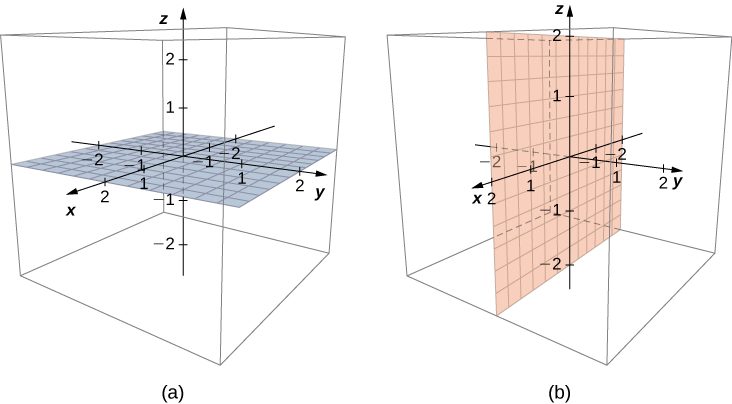Learning Objectives
- Write the distance formula in three dimensions.
- Write the equations for simple planes and spheres.
Writing Equations in [latex]\mathbb{R}^3[/latex]
Now that we can represent points in space and find the distance between them, we can learn how to write equations of geometric objects such as lines, planes, and curved surfaces in [latex]\mathbb{R}^3[/latex]. First, we start with a simple equation. Compare the graphs of the equation [latex]x=0[/latex] in [latex]\mathbb{R}[/latex], [latex]\mathbb{R}^2[/latex], and [latex]\mathbb{R}^3[/latex] (Figure 1). From these graphs, we can see the same equation can describe a point, a line, or a plane.

Figure 1. (a) In [latex]ℝ[/latex], the equation [latex]x=0[/latex] describes a single point. (b) In [latex]ℝ^2[/latex], the equation [latex]x=0[/latex] describes a line, the [latex]y[/latex]-axis. (c) In [latex]ℝ^3[/latex], the equation [latex]x=0[/latex] describes a plane, the [latex]yz[/latex]-plane.
In space, the equation [latex]x=0[/latex] describes all points [latex](0, y, z)[/latex]. This equation defines the [latex]yz[/latex]-plane. Similarly, the [latex]xy[/latex]-plane contains all points of the form [latex](x, y, 0)[/latex]. The equation [latex]z=0[/latex] defines the [latex]xy[/latex]-plane and the equation [latex]y=0[/latex] describes the [latex]xz[/latex]-plane (Figure 2).

Figure 2 (a) In space, the equation [latex]z=0[/latex] describes the [latex]xy[/latex]-plane. (b) All points in the [latex]xz[/latex]-plane satisfy the equation [latex]y=0[/latex].
Understanding the equations of the coordinate planes allows us to write an equation for any plane that is parallel to one of the coordinate planes. When a plane is parallel to the [latex]xy[/latex]-plane, for example, the [latex]z[/latex]-coordinate of each point in the plane has the same constant value. Only the [latex]x[/latex]– and [latex]y[/latex]-coordinates of points in that plane vary from point to point.
rule: equations of planes parallel to coordinate planes
- The plane in space that is parallel to the [latex]xy[/latex]-plane and contains point [latex](a, b, c)[/latex] can be represented by the equation [latex]z=c[/latex].
- The plane in space that is parallel to the [latex]xz[/latex]-plane and contains point [latex](a, b, c)[/latex] can be represented by the equation [latex]y=b[/latex].
- The plane in space that is parallel to the [latex]yz[/latex]-plane and contains point [latex](a, b, c)[/latex] can be represented by the equation [latex]x=a[/latex].
Example: writing equations of planes parallel to coordinate planes
- Write an equation of the plane passing through point [latex](3, 11, 7)[/latex] that is parallel to the [latex]yz[/latex]-plane.
- Find an equation of the plane passing through points [latex](6, -2, 9)[/latex], [latex](0, -2, 4)[/latex], and [latex](1, -2, -3)[/latex].
try it
Write an equation of the plane passing through point [latex](1, -6, -4)[/latex] that is parallel to the [latex]xy[/latex]-plane.
Try It
As we have seen, in [latex]\mathbb{R}^2[/latex] the equation [latex]x=5[/latex] describes the vertical line passing through point [latex](5, 0)[/latex]. This line is parallel to the [latex]y[/latex]-axis. In a natural extension, the equation [latex]x=5[/latex] in [latex]\mathbb{R}^3[/latex] describes the plane passing through point [latex](5, 0, 0)[/latex], which is parallel to the [latex]yz[/latex]-plane. Another natural extension of a familiar equation is found in the equation of a sphere.
definition
A sphere is the set of all points in space equidistant from a fixed point, the center of the sphere (Figure 3), just as the set of all points in a plane that are equidistant from the center represents a circle. In a sphere, as in a circle, the distance from the center to a point on the sphere is called the radius.

Figure 3. Each point [latex](x,y,z)[/latex] on the surface of a sphere is [latex]r[/latex] units away from the center [latex](a,b,c)[/latex].
The equation of a circle is derived using the distance formula in two dimensions. In the same way, the equation of a sphere is based on the three-dimensional formula for distance.
rule: equation of a sphere
The sphere with center [latex](a, b, c)[/latex] and radius [latex]r[/latex] can be represented by the equation
.
This equation is known as the standard equation of a sphere.
Example: finding the equation of a sphere
Find the standard equation of the sphere with center [latex](10, 7, 4)[/latex] and point [latex](-1, 3, -2)[/latex] as shown in Figure 4.

Figure 4. The sphere centered at [latex](10,7,4)[/latex] containing point [latex](−1,3,−2)[/latex].
try it
Find the standard equation of the sphere with center [latex](-2, 4, 5)[/latex] containing point [latex](4, 4, -1)[/latex].
Example: finding the equation of a sphere
Let [latex]P=(-5, 2, 3)[/latex] and [latex]Q=(3, 4, -1)[/latex], and suppose line segment [latex]PQ[/latex] forms the diameter of a sphere (Figure 5). Find the equation of the sphere.

Figure 5. Line segment [latex]PQ[/latex].
try it
Find the equation of the sphere with diameter [latex]PQ[/latex], where [latex]P=(2, -1, -3)[/latex] and [latex]Q=(-2, 5, -1)[/latex].
Watch the following video to see the worked solution to the above Try IT.
Example: graphing other equations in three dimensions
Describe the set of points that satisfies [latex](x-4)(z-2)=0[/latex], and graph the set.
try it
Describe the set of points that satisfies [latex](y+2)(z-3)=0[/latex], and graph the set.
Example: graphing other equations in three dimensions
Describe the set of points in three-dimensional space that satisfies [latex](x+2)^{2}+(y-1)^{2}=4[/latex], and graph the set.
try it
Describe the set of points in three dimensional space that satisfies [latex]x^{2}+(z-2)^{2}=16[/latex], and graph the surface.
Watch the following video to see the worked solution to the above Try IT.
Candela Citations
- CP 2.17. Authored by: Ryan Melton. License: CC BY: Attribution
- CP 2.15. Authored by: Ryan Melton. License: CC BY: Attribution
- Calculus Volume 3. Authored by: Gilbert Strang, Edwin (Jed) Herman. Provided by: OpenStax. Located at: https://openstax.org/books/calculus-volume-3/pages/1-introduction. License: CC BY-NC-SA: Attribution-NonCommercial-ShareAlike. License Terms: Access for free at https://openstax.org/books/calculus-volume-3/pages/1-introduction




